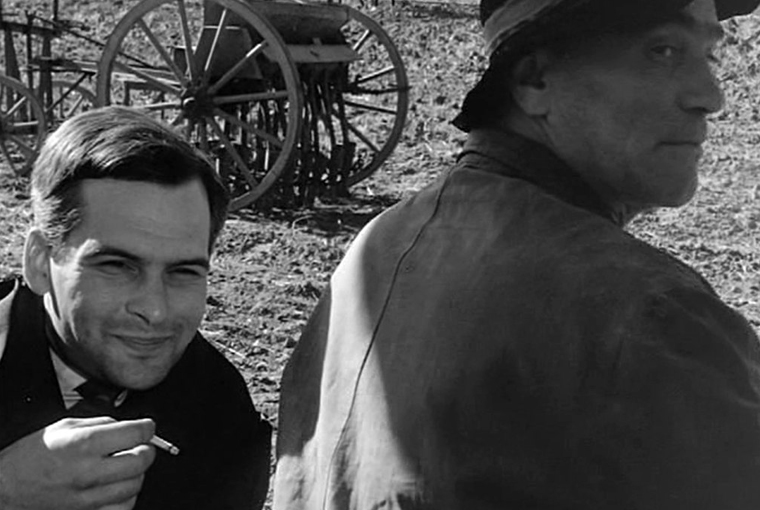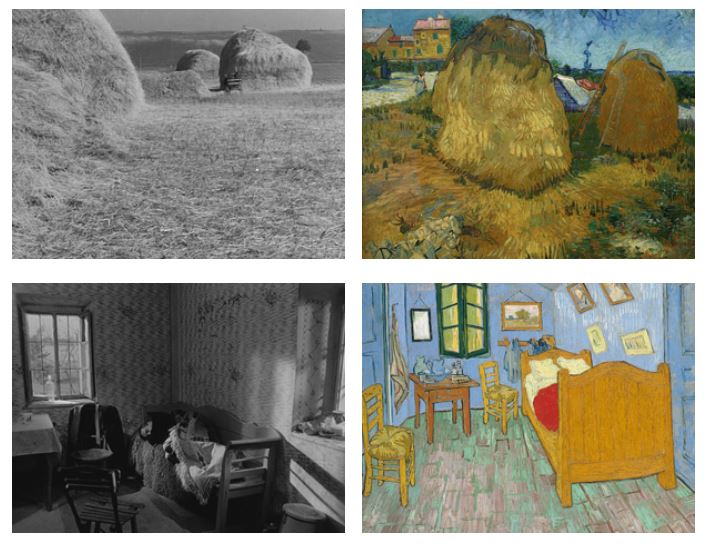Hungarian Existentialism
Miklós Jancsó’s Cantata (Oldás és kötés, 1964)
Vol. 27 (March 2013) by Moritz Pfeifer
From today’s perspective, Miklos Jancso’s second feature Oldás és kötés (Cantata) is like a chapter from Existentialism for Dummies. The movie is about a thirty-two year old doctor called Ambrus and his alienation from society, family and friends. Chain smoking, with slicked back black hair, and dressed in a dark suit, he would perfectly fit into the Parisian West-Bank café society of the 1960s. The jazzy soundtrack gives a finishing touch to this existential chic. But unfortunately Jancsó’s hero is unable to find like-minded spirits in the Budapest of 1964 as it is portrayed by the Hungarian director.
Ambrus is quickly plagued by social ennui. The pseudo-intellectual musings of his artistic friends makes him want to go to bed. In one scene, he escapes from a party to nap. The jazz is boring, and the women that admire him leave him cold. He continues his nap, when a blond woman tells him that she would like to spend the night with him. In short, Ambrus is a depressed loner. His attempts to make sense of his being in the world are thwarted by…well..his being in the world. But this is what the lonely side of Existentialism is all about. It describes the unhappy experience of not being able to become an independent, free-floating individual. If you love a blond woman, you depend on a blond woman. If you don’t love a blond woman, you may prove to yourself that you can take a decision, but you still depend on the blond woman because the reason you had to take that decision is still the blond woman. Freedom-wise, it’s a dead-end.
This kind of oh-my-god-I-depend-on-others awareness, and the anxiety it may produce is marvelously dramatized in an extensive operation scene that opens the movie. In this scene, Ambrus is supposed to make a complicated heart operation. Ambrus appears to be nervous but self-confident, and hence existentially-wise okay. One of the reasons why he thinks the operation will work out is revealed in a conversation with the husband of the patient. During the conversation, Ambrus tells the husband his ideology about surgery, describing it like a symphonic-like collaboration of highly qualified scientists. He compares this “communitarian” approach to the “individualistic” style of the old school, where the master surgeon does the job by himself and is judged by the skill of his hands, a skill which Ambrus dismisses as unscientific. In the next scene Ambrus is unlucky to find out that the husband had asked an old professor of the old school to perform the task. An even bigger blow for Ambrus follows when the professor saves the patient’s life after the work of the group had made her heart stop beating. Massaging her heart, he forces it to beat again with the skill of his hands.
After that, Ambrus loses his existential okayness. He takes a leave from work and goes on an aimless odyssey. He meets the blond woman, sees his empty artistic friends, and ends up in isolation. This sounds very philosophical, dramatic, and profoundly sad. And maybe Ambrus really had an ideology, or aspirations as a surgeon that were defeated because the professor was the lucky one saving the patient. But it is also essentially naïve and funny. The irony of the operating scene is that although Ambrus dreams of communitarian harmony, he really would like to be as individual and free as the professor whose hands are so powerful that they can even resurrect the dead. Ambrus admits this in his allegory about the symphonic nature of surgery, saying that he sees himself more like the conductor than a craftsman. It’s an existential double-bind. Ambrus aspires the very existential freedom he tries to overcome.
This kind of Existentialism may appear shallow. It resembles the awkward experience an adolescent may have when she rebels against someone she really identifies with. Seen in this way, Jancso’s Existentialism has many things in common with the plot-line of a dozen teenage movies (Breakfast Club, Heathers, She’s all that, etc.). In 10 Things I Hate About You, for example, the main character Kat (Julia Stiles) is supposed to not like boys and be all free-floating existentially independent until she starts dating Patrick (Heith Ledger), and gets all dependent and existentially lonely when she finds out that Patrick’s love is not as free-floating because, even though he really loves her, he was initially bribed into dating her. Most from-geek-to-prom-queen plots explore varieties of this experience. These characters become existentialist loners or geeks because they refuse to identify with the cool kids, who are cool because they depend on all sorts of unfree things – like using certain words, wearing certain clothes, and so on. And yet, and yet, teenage Angst still seems to make more sense than Ambrus’ hatred against people who, out of all things, save lives. There is a philosophical, dramatic, and profoundly sad motivation for feeling unhappy because people don’t like that you have freckles, or glasses, or because you wear no-name sneakers, and so on. Indeed, when teenagers rebel against authority, they mostly have a real reason to feel existentially not okay. Think about the institutionalization drama Girl, Interrupted (1996), or about Igby Goes Down (2002), where the main character’s Angst starts when he is sent to military camp.
Jancso’s Ambrus, however, is not a rebel. He’s simply depressed about having made the wrong choices in life, maybe for being able to chose at all. Ambrus returns to his father’s farm in the second part of the movie, trying to reestablish family ties. Like the professor, his father is a lonesome individualist who seems to be at ease with the world and with himself. Since he’s a peasant, he’s also a “craftsman” which recalls the brain vs. dexterity distinction of the competing surgical methods that opened the film. Ambrus encounters his father in the same love-hating way in which he encountered the professor. He loves him because he represents the free man, and hates him because, although he would like to have the same independence and control, he wouldn’t want to be a peasant. Again it’s the sort of ideal/reality distinction that came out of the surgery scene. The father seems to be so existentially free that he predicts the time of his own death in one conversation (just as the doctor was able to give life). But despite this apparent freedom and control, the reality of his peasant family appears to be completely unfree and undesirable to Ambrus. After the conversation with his father, Ambrus blames his brother for not pursuing higher education, and making something of himself.
Oldás és kötés is full of references. The movie opens with a student reading out of a Jean Giono book. Later Ambrus listens to Bartók’s Cantata Profana: The Nine Enchanted Stags (1930), which also gives the film its international title. The Bartók text is based on a Romanian myth where a father loses his nine sons to a spell transforming them into animals. Like Ambrus, the nine sons in the story are bound to live a life astray, never able to return back home. Jancso also draws upon various pictural references. When Ambrus travels back to his father, there are two iconic allusions to Van Gogh’s paintings Haystacks in Provence, and Bedroom in Arles. The two scenes follow one another which makes the painterly impression appear like a hommage. Especially the room looks like a 3D reproduction of the Van Gogh painting. Quantity and position of the furniture exactly matches that of the painting, although it would have been impossible for Jancsó to show the left wall (thus the chair in the movie is awkwardly placed in the middle of the room). But Jancsó preserves the lack of perspective in the painting which can be seen in the distortion of the upper left corner of window.
Clockwise from the top left: Oldás és kötés, outside Ambrus’s father’s farm; Van Gogh’s “Haystacks in Provence,”; inside Ambrus’s father’s farm; “Bedroom in Arles”.
Maybe Jancso recalls these paintings because of their existential force. In 1888, Van Gogh moved to Arles in the hopes of attracting other artists to join him and start something like a utopian colony. He tried to convince Paul Gaugin to come, and is expecting a visit from the painter when he is drawing his room. His spirits are high, and his character and palette lighten up. The bedroom series was intended to express “rest or sleep.”1 These feelings seem at odds with the paintings. The bedroom is distorted. The chair on the right, for example, seems to collapse, which would make it considerably difficult to “rest” on. The wooden planks, in psychedelic green, may be the reason why some people fail to see the calmness in the painting. A week after finishing one version of the bedroom, Van Gogh would say that he is “once again nearly reduced to the state of madness.”2 Gauguin would never agree to settle permanently in Arles, and subsequent fights would make him leave Van Gogh. Maybe, Van Gogh, like Ambrus believed things that were incompatible with the reality he lived in. And maybe this is why Jancsó decided to make his little homage to the painter.
But the difference between the Existentialism of these paintings and the Existentialism in Jancsó’s movie is that whatever made Van Gogh lonely, and unhappily dependent, also makes him profoundly happy, independent and free. Being able to make art is reason enough for the painter to find a meaning in life. The loneliness Van Gogh embodies, with all its suffering and existential pain, is also a sign of his independence and freedom. More than ten years earlier, fighting with the idea of becoming a painter, Van Gogh writes to his brother:
It seems to me to be new proof, as it were, and a sign like others that I think I’ve been noticing recently, that my efforts will be blessed, that things will go well for me, and the thing I desire so fervently will be granted me – something of the faith of old has come alive in me that my thoughts shall be established and a right spirit renewed and the soul restored to the old faith. I alone am making a choice for my life.3
This kind of freedom of choice, is of course not really free. It’s like the freedom the geek from the teenage movies has who, abiding bullying and harassment, still decides to commit to some passion . Sartre famously claimed that freedom is “…what you do with what’s been done to you.”4
Jancsó’s hero lacks a genuine reason to be existentially upset. Oldás és kötés is a film about a man who is simply frustrated that the reality he is living in is not like the one he dreamed of. And that’s okay. How would you behave if you’re friends would spend nights pondering on the iconographic meaning of films about stuffed chickens with knives in their breasts? Maybe you would start thinking about what it means to have friends, and get all depressed and lonely about the fact that you had a different idea about friendship. But by the end of the day, this may be a healthy reaction, and may even give you a reason to find new friends. But these problems are not big enough to be relevant in the existential anxiety sense, and not small enough to illustrate the meaninglessness or absurdity of life. Jancsó is clearly undecided here. Although supposedly de-dramatizing and formalist, his film, like his character, over-dramatizes a petty conflict.
Almost all critics compare Jancsó’s film to another existentialist movie, Antonioni’s La Notte (the director admitted to having been inspired by the Italian movie). But unlike Jancsó, Antonioni avoids finding circumstantial factors that could explain the existential emptiness of his characters. One of the reasons why Antonioni’s characters are so forlorn is precisely the fact that they don’t understand the reasons for this emptiness. But this is what Existentialism is all about. Existentialism avoids the why question because it sees life as essentially absurd. To think that there can be a reason for someone to lack reasons is defying the notion that there are no reasons to begin with. Jancsó deeply misunderstood Existentialism, taking from it only aesthetic clichés. In the end, his film resembles a psychological drama where a man is tortured by nostalgic sentimentalism for his childhood.





Thank you for this lucid insight into Jansco’s Cantata. I am presently working my way through this director’s fascinating oeuvre which, unfortunately and undeservedly, seems to be unduly neglected in the UK. My recent discovery of the EEFB has opened up a fine resource for Eastern European film.
Best Wishes, Don Williams
While this essay on Jancsó’s second feature film is insightful and rightly points out the existentialist motifs, it completely ignores how histrorical traumas erupt in the film, and how they influence the protagonist’s character. First, the evocation of the holocaust, then the verbal allusions to the harsh stalinist period in Hungary (roughly 1949-1956).